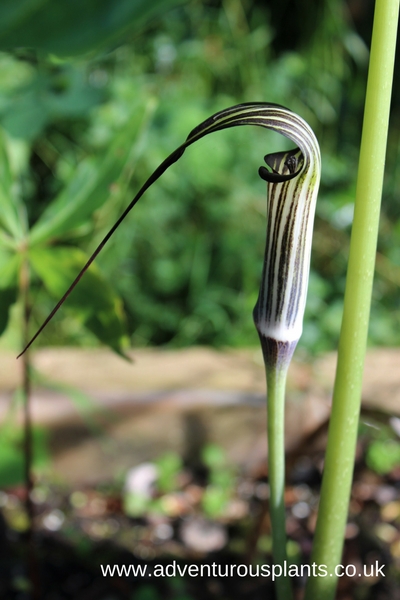Growing Arisaema from bulblets
How to grow Arisaema bulblets:
In addition to setting seed, Arisaema also reproduce asexually by producing bulblets or small offsets from the parent tuber. Whilst seed will be required to propagate large numbers of plants, the bulblets are a useful source of plant material, and it is perfectly possible to propagate a plant by growing these bulblets on. It is important to note that a bulblet will be an exact genetic copy of the parent, whereas each seed will produce a genetically distinct individual.
Bulblets and Stolons
Many Arisaema species make bulblets. For example, mature specimens of Arisaema consanguineum and Arisaema taiwanense can be quite prolific. The bulblets grow attached to the parent tuber, and slough off at the end of the growing season if they are ready. Some species make stolons. These are long runners that radiate from the tuber with a bulblet on the end. The runner breaks down in the soil, leaving the bulblet some distance from the parent tuber, ready to make a new plant. Such species include Arisaema concinnum, Arisaema ciliatum and Arisaema exappendiculatum amongst others.

Getting bulbets to grow
Some bulblets seem easy to grow. For example, Arisaema consanguineum seems readily propagated via its bulblets, and it is generous in producing them. And yet, for a number of years, I struggled to get bulblets from several other species to grow and form roots. In the end I contacted a friend and asked him for some advice. I’ve detailed that advice here, and hopefully it will prove helpful to others, as it has been to me. It turned out I was just being impatient…
Here’s the gist of what he said: It is important to understand that an Arisaema tuber is actually an underground stem. This is difficult to comprehend at first, as the tubers look nothing like a more familiar plant stem. The bulblet is a sidebranch that eventually breaks away, and forms a new plant. Before it detached, it got its nutrients from the tuber, at its base. However, once it is detached, it has to divert all its systems to the apical shoot at the top and feed itself through its own roots. This rearrangement takes time, and patience is required for this adjustment to take place!
Some species can need an entire year in the soil, experiencing the annual temperature fluctuations of a normal yearly cycle before they break dormancy. Many bulblets shed a skin after their first year and physically change shape before they will start to grow. It looks like it is doing nothing, but the tuber will be working hard adjusting itself to a new life detached from its parent. The bulblet will eventually change into a small globose shaped tuber, and from this moment on, it can be grown as normal.
The bulblets that are formed on the end of stolons are generally quicker to start into growth. The process of rearrangement in the bulblet starts during the season that the stolon is produced and whilst the runner connecting it to the parent tuber starts to degrade.
Here’s how I grow my Arisaema Bulblets
Here’s how I go about growing my bulblets – I have had very good success by following this procedure, rather than simply potting them up in my regular compost mix: Firstly, it is important to note – never physically snap or cut the bulblets off the parent tuber! They need to easily come away at the lightest of touches, or have separated naturally. Place the bulblet in a small clear plastic bag, such as a re-sealable freezer / food bag, along with some just moist vermiculite. You can easily open the bag to check on progress at any stage, and if the bulblet does start up into growth, it can be quickly spotted through the clear bag. Allow the bulblet to go through a normal cycle of temperature fluctuations – i.e. just leave it alone and don’t place it in a heated propagator. And then wait. Patience is required. As long as the bulblet remains firm, it is ok.
Sometimes a full annual cycle is needed before it will grow, so never throw them out. Once it has formed roots and is developing a shoot, it is a simple job to carefully pot it up.